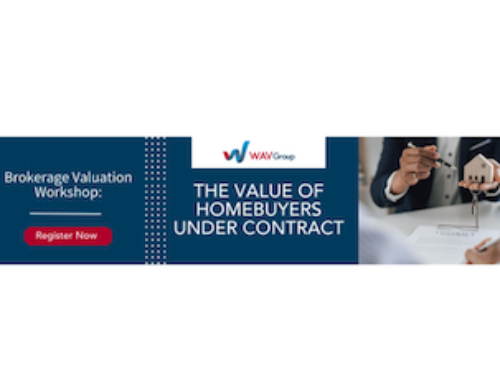Last week, the WAV Group M&A team hosted a webinar for more than 300 brokers as the final episode of our webinar series for our book, Acquiring More Profit. In our final episode, co-author George Slusser and I reviewed the final stage of a merger – Evaluating Your Results. We welcomed Nicole Rideout Hartwick of Gibson Sotheby’s and Matt Rand of Howard Hanna Rand Realty as panelists. Both firms close numerous acquisitions each year. Immediately after the webinar, a number of brokers who have never executed a transaction before reached out to get advice on how to get started. A lot of this information is in the book, but one item that we did not write about is a self valuation.

Are you a buyer or seller?
The first question that a brokerage should answer for themselves is if they are a buyer or seller. Regardless of size, this is always the most important question to explore. We all know that if someone came along with an unbelievable offer, it would be a no-brainer to sell. However, the regularity of unbelievable offers is extremely limited, especially in a low margin business like real estate brokerage. Similarly, if someone wanted to give you their brokerage because they are tired of running it, most firms would accept. This is also an unlikely scenario.
The best way to answer this question is to have a valuation done on your business before you initiate conversation with another firm about a merger or acquisition. WAV Group can perform the valuation for you, or you can use the worksheet offered in our Implementation Guide and do it yourself. Either way, you can start out by looking at your own business. You must evaluate the business as if a “third party” absentee owner was involved. Adjustments are made for what expenses they may need to add, or what expenses they would not need to incur. Be honest about the true profitability of your firm, not just what the financial statements might tell you. Would you buy your brokerage today? Would you sell it for the multiple of EBITA ranging from 3X to 6X?
Exploring the question of being a buyer or seller of your company is the best way to understand as to whether you are in fact the buyer, and when you might be the seller.
Trade Multiples
Today, smaller firms are usually trading for 3X to 4X of the trailing twelve months Adjusted EBITDA, but larger firms with more than $1B in transaction volume are likely to see 5X to 6X. These are general numbers that will simply get you into the ballpark of what brokerage firms are trading for. The terms of the deal can move the needle on the multiple in many ways. Like an AVM, these multiples get you close, but your company is worth the exact amount that you are willing to accept from a buyer – driven by many motivations, synergies, opportunities, and culture. Some firms simply fit together very well, producing higher valuations. At other times, the fit is OK, leading to lower valuations. It’s like the perfect house vs. an adequate house.
Other Getting Started Basics
Data helps. Nearly every broker is looking at marketshare data every month. Most firms can use the knowledge about a competitor’s commission plans and the local operating costs to estimate how a brokerage is performing. Use those market share reports and your knowledge of the key agents at a competitive firm to define your prospect list.
Meet with potential candidates. George Slusser often likes to use the analogy of “It’s Just Lunch” to discuss prospecting for M&A trades. Compatibility and culture are the ingredients that make for great transactions – far more impactful than the price paid. Price is what you pay, value is what you receive. In our webinar, Matt Rand shared a story about a merger that took 9 years to happen! The important lesson here is that you need to get out and socialize with your competitors, much in the same way you recruit agents. It’s a sales pipeline.
Some owners do not like the prospecting part of M&A, which is fine. If you are looking to buy or sell, WAV Group can get you started. You need to be prepared to take the meeting, but we can help you get there.
Once you get started, keep going. Rinse and Repeat.

There are 180,000 operating real estate brokerages in America according to NAR estimates. Lots of fish in the pond. Start casting!




This webinar recap is incredibly helpful for anyone diving into brokerage mergers and acquisitions. Understanding whether you’re a buyer or seller and grasping trade multiples are crucial steps in the process. And the tips on using market share data and meeting potential candidates are invaluable. Thanks for sharing such insightful advice!
For more useful insights and tips on real estate, make sure to follow housingbuddy . They always share great content to help navigate the real estate world!